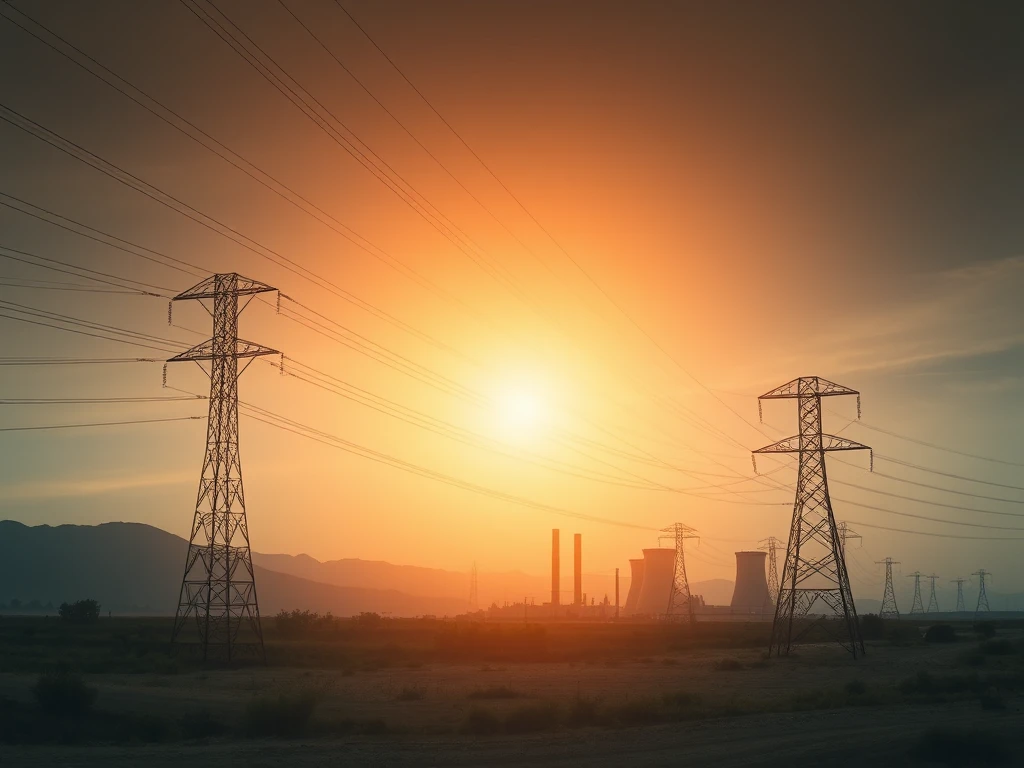Pakistan Bitcoin Mining: Ambitious 2000 MW Plan to Tackle Energy Crisis Explained

Imagine a country struggling with high energy costs and power shortages, yet having thousands of megawatts of electricity sitting idle. This is the paradox facing Pakistan, a nation now exploring an unexpected solution: using that idle power for Pakistan Bitcoin mining. Could this bold move truly fix Pakistan’s energy problem and boost its economy?
The Pakistan Energy Crisis: A Costly Paradox
As of early 2025, Pakistan had significant installed power capacity, but a substantial portion — almost 14% or roughly 6,500 MW — remained unused, particularly during periods of low demand like winter. The core issue isn’t a lack of power plants, but a financial burden called ‘capacity payments’. These are fixed fees paid to power producers even when they aren’t generating electricity, costing the nation trillions of rupees annually (billions of US dollars).
Several factors contribute to this complex situation:
- **Underutilized Thermal Plants:** Fossil fuel plants make up over half the capacity but generate less, with older, inefficient units kept on standby, collecting payments.
- **Renewable Integration Challenges:** Rapid solar adoption, while positive for clean energy, creates grid instability due to fluctuating supply.
- **High Consumer Costs:** Businesses face high electricity rates (around 16¢/kWh), fueling a rush to net-metered solar, which in turn can increase costs for those who cannot afford solar.
This expensive, unstable energy landscape creates the backdrop for Pakistan’s unconventional Pakistan crypto strategy.
Pakistan Bitcoin Mining Strategy: Turning Wasted Energy into Revenue
Facing this costly energy paradox, Pakistan announced a plan in May 2025 to redirect up to 2,000 MW of idle electricity towards Bitcoin mining and AI data centers. This initiative is spearheaded by the Pakistan Crypto Council (PCC), led by Bilal Bin Saqib.
The core argument is simple: monetize wasted off-peak electricity. By consuming surplus power that would otherwise go unused (and still be paid for), Bitcoin mining could generate revenue through digital assets. This also helps stabilize the grid by providing a constant load for underutilized plants.
The plan gained international attention, with coverage from major news outlets and even involvement from figures like Binance co-founder Changpeng Zhao, who was appointed a strategic adviser to the PCC. The government defended the plan by highlighting the potential for hundreds of millions in annual revenue and job creation, contrasting it with the significant cost of idle plants.
How the Bitcoin Mining Pakistan Energy Plan Works
Implementing this ambitious strategy involves several key steps:
- **Repurposing Existing Infrastructure:** The initial focus is on utilizing underused coal power plants, some operating at minimal capacity but still incurring significant costs. The idea is to transform this financial liability into a revenue stream, though concerns about environmental impact remain.
- **Attracting Investment:** Pakistan aims to attract foreign mining and AI companies by offering incentives like customs breaks on ASIC mining machines. Success requires these companies to set up operations close to power sources to minimize transmission losses.
- **Developing Digital Frameworks:** A National Bitcoin Wallet is planned for government reserves, alongside a Pakistan Digital Asset Authority (PDAA) to handle licensing, taxation, and compliance.
- **Addressing Pricing:** A major hurdle is the cost of electricity. Commercial rates are high, so a subsidized rate (reportedly $0.09/kWh) is proposed to make mining competitive. However, this faces potential scrutiny from the IMF.
Benefits of Idle Power Bitcoin Mining in Pakistan
Proponents argue the strategy offers multiple advantages:
- **Revenue Generation:** Converting surplus, otherwise wasted electricity into high-value digital assets like Bitcoin.
- **Grid Stabilization:** Providing a consistent demand for underutilized power plants, potentially easing grid strain during off-peak hours.
- **Attracting Foreign Investment:** Incentives aim to bring in global tech companies, fostering high-tech job growth.
- **Strategic Positioning:** Leveraging Pakistan’s location to become a hub for data centers and digital innovation.
- **Building a National Reserve:** Accumulating mined Bitcoin as a long-term sovereign asset.
Challenges for the Pakistan Crypto Strategy
Despite the potential, significant hurdles exist:
- **Sustainability Concerns:** Relying on older coal plants for continuous mining raises environmental questions and concerns about long-term energy mix goals.
- **Grid Reliability:** Pakistan’s grid is known for inconsistencies and losses, posing a risk to operations that require uninterrupted power.
- **IMF Scrutiny:** The plan, particularly any energy subsidies, could complicate ongoing negotiations with the IMF for financial assistance.
- **Energy Security:** Concerns exist that power could be diverted from households or industry, potentially worsening existing shortages or driving up consumer costs.
- **Regulatory Ambiguity:** While new authorities are planned, the overall legal framework for cryptocurrency remains unclear, potentially deterring investors.
What’s Next for Pakistan Bitcoin Mining?
Phase 1 targets 2,000 MW using existing infrastructure. Future phases reportedly aim to integrate renewable energy sources. A critical factor for the plan’s success is securing approval from the IMF, given their historical caution regarding sovereign crypto exposure and energy subsidies.
Ultimately, the success hinges on attracting and retaining global mining and AI operators. While initial interest is reported, the real test will be the actual deployment of the allocated power, demonstrating Pakistan’s ability to offer stable, competitive electricity and navigate the complex regulatory environment.
Conclusion
Pakistan’s strategy to use idle power for Bitcoin mining is a fascinating, albeit risky, approach to tackling its energy and economic challenges. It presents a unique opportunity to monetize wasted resources, attract investment, and potentially stabilize the grid. However, it also faces significant hurdles related to sustainability, grid reliability, international financial scrutiny, and regulatory clarity. Whether this ambitious 2,000 MW plan becomes a sustainable solution or a temporary fix remains to be seen, but it certainly marks a remarkable shift in Pakistan’s stance on digital assets.









